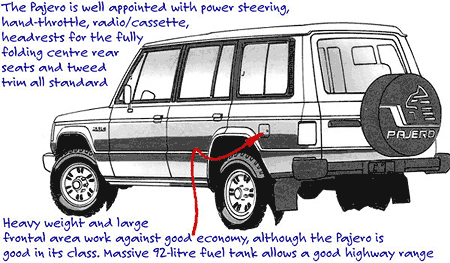BY MALCOLM LIVERMORE | 25th Jul 2003

Originally fitted with a 2.6-litre, four-cylinder engine, the Pajero was the first four-wheel drive to move to the now popular V6 engine configuration. The EXE long wheelbase 4WD Pajero wagon version is available in 2.6 petrol or 2.5 turbo-diesel versions.
The 2.6-litre "Astron" four-cylinder, with its twin balance shafts for smoothness, is familiar to Australians it is a carburetted version of the engine used in the Magna sedan except that in this case it is installed longitudinally in the engine bay with a rear-mounted gearbox and transfer case.
Producing 79kW of power and 192Nm of torque, it does a manful job of motivating the Pajero, partly helped by the fact the vehicle is not as heavy, at 1645kg, as bigger four-wheel drives such as the Nissan Patrol and Toyota LandCruiser.
In that company, it manages reasonably well on fuel consumption.
The engine is coupled to a five-speed manual transmission. Automatic was only available in the V6 Superwagon. A limited-slip rear differential is standard to give extra grip when needed.
The suspension tends to make the Pajero a more comfortable vehicle on the open road than the full-size four-wheel drives.
The front is independent, with wishbones and torsion bars, while the rear has leaf springs with a live axle (unlike the turbo-diesel EXE and the V6 Superwagon, which use coil springs located by a unique three-link arrangement).
When pushed into corners, the Pajero shows some body roll but handles well on all surfaces. The Pajero seats up to seven people, thanks to two small transverse fold down seats in the rear. These are suitable for children only.
The strap retainers on these rear seats can develop an annoying rattle when the seats are not occupied.
The Pajero has a high standard of fit and finish with tweed trim providing a touch of luxury. Power steering, radio/cassette, white "styled" wheels and a side-support adjuster for the front seats are standard.
With a body design dating back to 1984, the 1989 Pajero looks boxy, in contrast to its stylish 1991 successor. But with good appointments and overall comfort, the Pajero EXE is an excellent choice for buyers in the 4WD family wagon market.